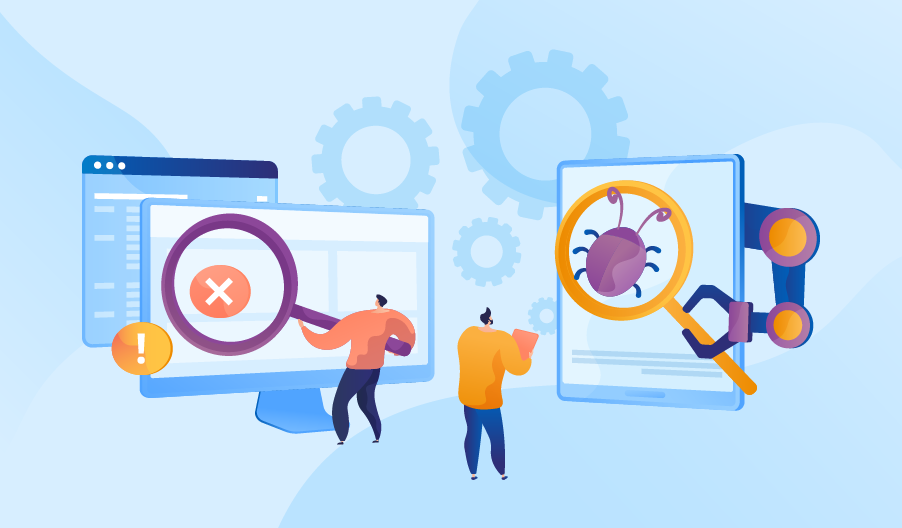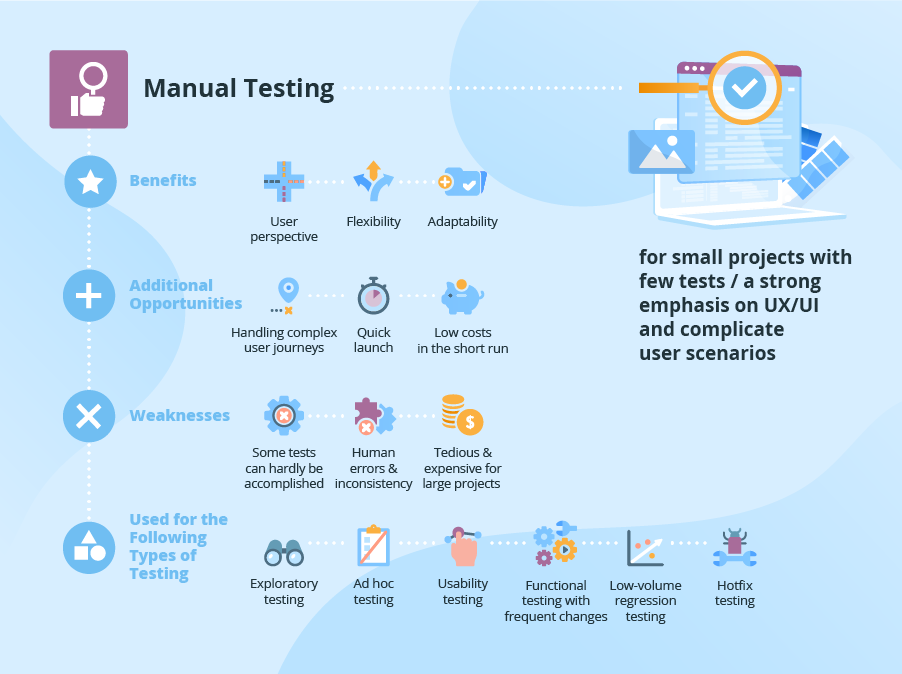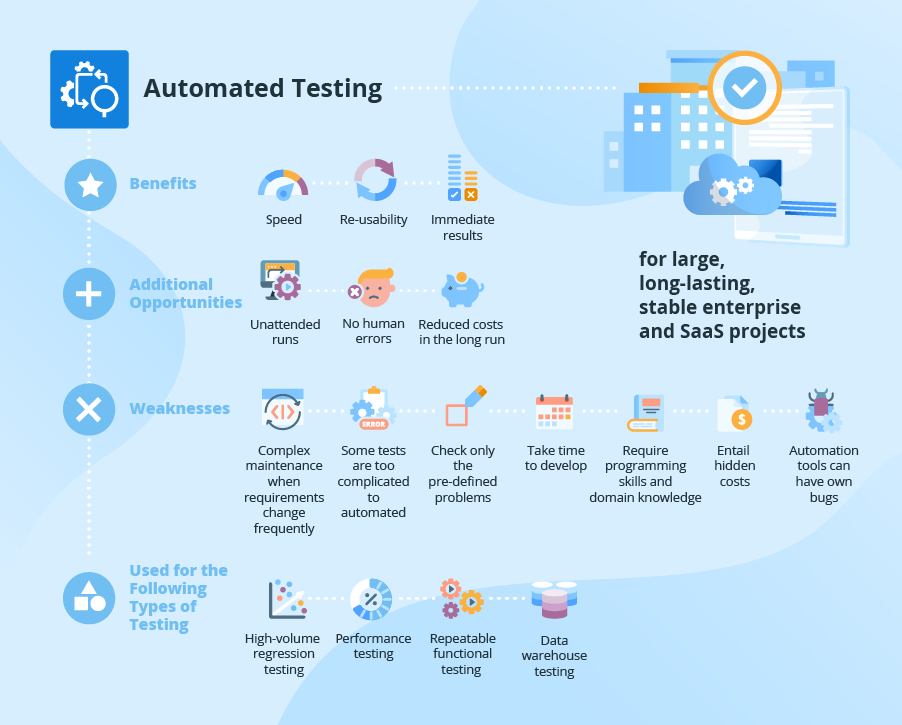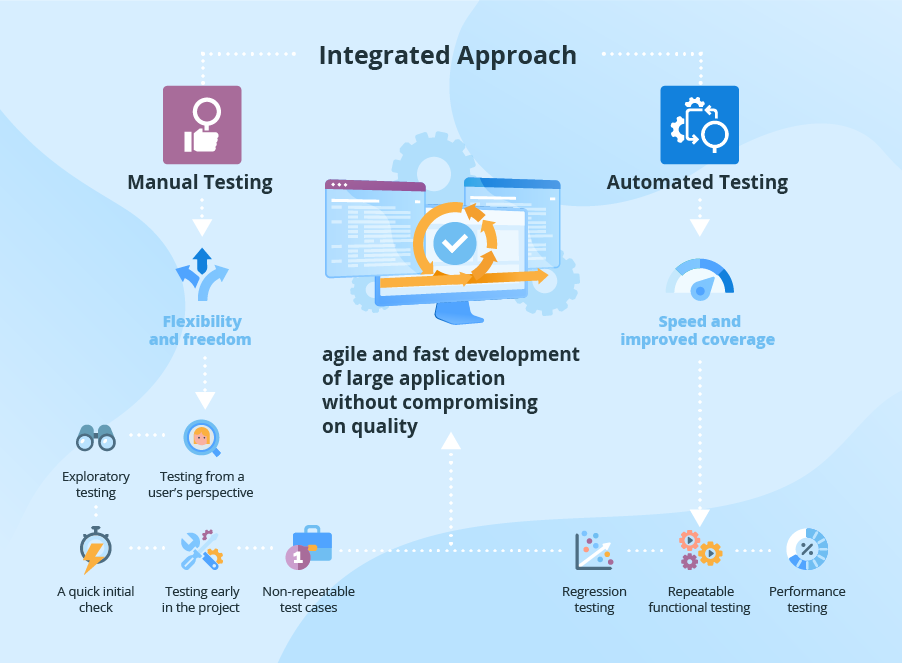Manual Testing Vs. Automated Testing Vs. Integrated Approach: The Right Way to Test Modern Apps
Editor’s note: When it comes to testing modern applications, you have at least three possible options. Confused about your perfect choice? With practical knowledge in the field, ScienceSoft’s QA team is here to help.
Since the recent hype around automation in software testing, many businesses request our assistance in choosing the best approach for their software testing — test software manually, use automated tests or opt for a mix of both. If you are in doubt too, our structured guide will walk you through the highlights of each approach and reveal their salient distinctions that will be useful in making the choice.

Manual testing
Manual testers simulate all steps of a user journey and check that users see exactly what they need to see, and that an application sends and processes requests as it is supposed to.
Major benefits of manual testing:
- User perspective: Only a pair of human eyes can spot such issues as inconvenient workflows and design, fonts, sizes, and unclear error messages, etc.
- Flexibility: Manual testers have the freedom to employ creativity and question things that were not predefined.
- Adaptability: Manual testers can verify new features or any changes in design without special preparation.
Additionally, the manual testing process provides the following opportunities:
- It can handle user journeys of any complexity.
- It is relatively quick to launch.
- It is low-cost in the short run.
However, testing by hand has the following weaknesses:
- Some testing types can hardly be accomplished manually (stress, load, scalability testing).
- Manual tests are subject to human errors and inconsistency.
- Repeated tasks (like regression testing) are tedious for testers and expensive for large projects.
Manual testing is most often used with the following types of testing:
- Exploratory testing.
- Ad hoc testing.
- Usability testing.
- Functional testing with frequent changes.
- Low-volume regression testing.
- Hotfix testing.
Manual testing is better suited for small projects with few tests or a strong emphasis on UX/UI and complicated user scenarios.

Automated testing
In the automated software testing process, test scripts execute all test steps automatically. To develop test scripts, validate and maintain test code, test automation engineers employ specific test automation tools. ScienceSoft’s test automation engineers prefer such tools as Selenium, Appium, Protractor and Ranorex. For details, you can check our recent overview of these and other popular automation tools available on the market.
Major benefits of automated testing:
- Speed: Although they may take longer to launch, automated test execution is faster than manual operations. For increased speed, automated tests can be parallelized and run simultaneously on several browsers, platforms and devices.
- Re-usability: Once created, test code can be used as many times as required.
- Immediate results: Test results are generated automatically and become available in real time for all testing stakeholders.
Apart from that, automated tests offer the following advantages:
- Automated tests can run unattended (e.g., to verify nightly builds when testing goes in parallel with development).
- Automated tests are not prone to human error.
- Automated testing offers reduced costs in the long run.
At the same time, automated testing has its own weaknesses:
- Requirement changes will entail test code adjustments for all relevant test cases.
- Some tests are too complicated to automate.
- Automated tests check only the pre-defined problems.
- Automated tests take time to develop.
- Automated testing requires programming skills and domain knowledge.
- Testing tools, test code verification and maintenance entail additional costs.
- Tools for automated testing can have their own bugs.
Automated testing is of most help for the following types of testing:
- High-volume regression testing.
- Performance testing.
- Repeatable functional testing (if tests can be automated relatively easy, are reusable and rarely changed).
- Data warehouse testing.
Pure automated testing better suits large and long-lasting enterprise and SaaS projects that are relatively stable.

Integrated approach
In our test automation services, we choose an integrated approach that combines manual and automated testing to reap the best of each. In our testing projects, this approach allowed achieving max software quality while supporting frequent releases and staying cost-effective.
The major benefit of the integrated software testing approach is that it combines:
- The flexibility and freedom of manual testing
- The speed and improved coverage of automated tests.
We at ScienceSoft employ manual testing for:
- Exploratory testing.
- Testing from a user’s perspective (simplicity, visual aspects).
- A quick initial check of new features and UI changes.
- Testing early in the project, when UX and new features are rapidly evolving and automated tests are still being designed.
- Non-repeatable test cases.
And use automated tests in:
- Regression testing.
- Repeatable functional testing (relatively stable).
- Performance testing.
The integrated testing approach is ideally suited for the projects where builds are frequent and require fast verification, especially those with the established process of continuous integration and delivery.

What testing approach does your business need?
With each testing approach having its own pros and cons, it can be overwhelming to choose the one that will work best for your project. ScienceSoft’s QA consultants will help you choose the approach most suited for your project, taking into account your specific project needs and priorities.

